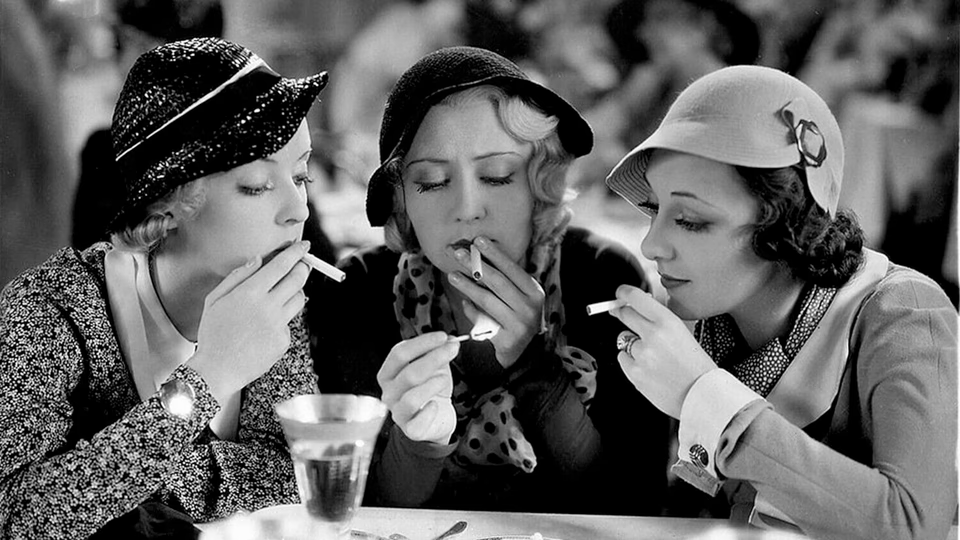Three on a Match

Until a 1948 Supreme Court ruling, the five major Hollywood studios controlled the entire movie business, from production to distribution. The studios contracted performers and paid them a salary. The performers worked long days, five days a week. If a film wrapped at lunch, they ate then began another. Thus, films like Three on a Match came stock-piled with current and future stars.
The story opens with a montage of newspaper headlines. Jack Dempsey wins the world heavyweight title. Prohibition passes. Women’s suffrage passes. Then, a smaller article. The New York City schools reopen after summer vacation.
Cut to Public School 64. The camera pans back to reveal a schoolyard teaming with children. Hundreds of them. Were they not twirling about, playing on slides and swings, it would pass for a prison yard. Here, we meet three pre-teen girls.
Exhibitionist Mary doesn’t mind her bloomers showing while she’s playing on the swing or the attention it garners from the boys. Much to the chagrin of class-beauty Vivian. When Mary skips class to smoke cigarettes with some boys, Vivian wants to tell on her. Studious Ruth dissuades her.
Time passes with more headlines. The girls prepare to graduate. Ruth is valedictorian. Vivian is voted most popular. Mary’s racked up so much trouble, she’s almost held back.
After the ceremony, Ruth and Vivian talk about their futures. Ruth’s family can’t afford her going to high school, so she’s off to secretarial school so she might get a job. Vivian, however, is off to an exclusive boarding school. They both wonder what will become of Mary.
More time passes. It’s 1925 now. The girls are teenagers. Mary, now played by Joan Blondell, is in reform school. Vivian, now played by Anne Dvorak, is reading lewd romance novels to her rapt roommates in Miss Jasons School for Young Ladies. Ruth, now played by Bette Davis, toils away in secretarial school.
Now it’s 1930. Mary sits in a beauty parlor telling her beautician how she ran into Ruth earlier that day and how she hasn’t seen her since their days at Public School 64. Vivian, at the same beauty parlor, overhears Mary’s mention of Public School 64. Reunited, the three women have lunch.
Something I love about the pictures of this era. Running just over an hour, efficiency was paramount. Here, they cram ten years of backstory and characterization into ten minutes.
The girls catch up at lunch. Mary, now a stage actress, has just landed her first break. Ruth is working as a secretary. Vivian has married a wealthy lawyer and has a three-year-old son. Mary and Ruth envy Vivian. But Vivian appears restless and bored with her life.
Weeks later, Vivian talks her husband, Robert, into letting her travel with their son to Europe. A reluctant Robert agrees and sees her off on the ship.
After he leaves, but before the ship sails, Vivian runs into Mary, who’s now a bona fide stage star. Mary, there to see a friend off, invites Vivian to a party. Vivian has the ship’s stewardess watch her son and joins Mary’s party, where she drinks and flirts with a young rake named Michael. Before the ship leaves port, Vivian takes her son and debarks with Michael.
From here, Vivian descends into a drug-and-alcohol-fueled nightmare. We see her strung out on the sofa, while her son, dirty and unwashed, begs for some healthy food.
Mary, feeling responsible, visits Robert and tells him where to find Vivian. Robert reclaims his son and divorces Vivian. Mary and Robert grow closer. On the day his divorce is final, he asks Mary to become his wife. Mary agrees. Ruth joins the family as a nanny.
In between, we have the obligatory pre-code shot of a woman putting on her stockings. Here, it’s Bette Davis.
Meanwhile, Vivian continues her fall from grace. Michael harbors a gambling problem, and their combined addictions have left the pair desperate for money to feed their habits. Vivian, waiting outside the same uptown apartment building she once called home, begs Mary for money. After they burn through that, Michael tries extorting Robert. When that fails, Michael kidnaps Robert’s son.
One of Michael’s creditors, a mobster named Ace, played by Edward Arnold, gets wind of the plot and muscles his way in via his henchman, played by Humphrey Bogart.
Though still regulated to a heavy, Bogart’s dialog proves more articulate than usual. When the kid says, “You mustn’t hurt my mama,” Bogart replies, “Okay, I’ll bear that in mind,” with a menacing glare.
Anyway, the ransom plan falls apart. With the heat closing in, Bogart leans on Michael to off the kid. Vivian, in a moment of lucidity during her withdrawal haze, saves her son in a startling (and over the top) fashion.
It’s a lot of plot for sixty-three minutes. Things move so fast we’re not given much time to ponder the insanity. Vivian’s fall from society lady to street-corner junkie plays like a caricature. Granted, her son’s incessant whining might drive anyone to drink. Mary wastes her school years getting into trouble and ends up a society darling. Vivian spends her life doing what’s expected of her and sees her world collapse the first time she steps out of line. And Ruth, poor Ruth. She toils away only to end up working for Mary. How’s that for a mixed message?
And did I mention we meet Edward Arnold as he’s plucking his nose hairs in a shaving mirror? Or Vivian picking up an obvious cocaine addiction? Or how, when Vivian’s moaning from withdrawal, one of Ace’s gang goes into her bedroom and slaps her around to quiet her?
Sure, it’s crazy, but seeing a cast this strong commit to such inane material proves a fun ride.